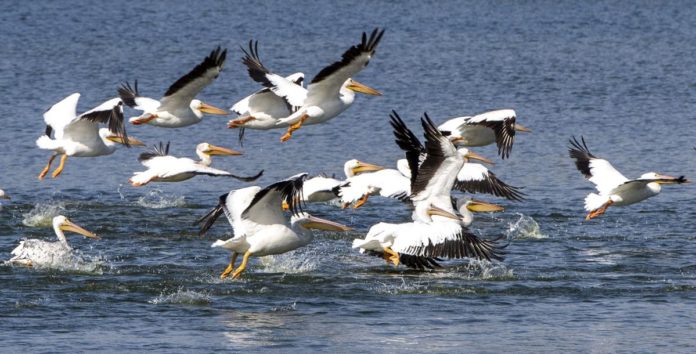The American white pelicans have arrived in Baton Rouge.
For over a decade, the flock of majestic birds has been stopping over in Baton Rouge, many of them congregating at the lakes near LSU.
Unlike our resident brown pelicans, the white pelicans spend a few months here before heading back north to nest and breed, said Rob Dobbs, the nongame ornithologist with Louisiana Department of Wildlife and Fisheries.
Most of them breed in Canada, Montana and North Dakota, he said.
“Now is the time when most of the birds are here in peak numbers,” Dobbs said. “There are hundreds of them, flocks migrating to southern coastlines in Texas and the lower Mississippi River area in general.”
In the shallow waters of the LSU lakes, you’ll see the pelicans swimming across the surface of the water, dipping their bills in and scooping up fish, minnows, crawfish and salamanders in their pouch.
The pelicans may even join forces, lining up and driving fish toward shallower water.
Brown pelicans, which are the Louisiana state bird, flap their wings and glide low over the surf or plunge from high in the air to capture fish in their bills, and mostly stay on the Louisiana coast, where they breed and nest year-round.
Contrary to popular belief, a pelican’s pouch is not used like a basket to carry fish. It is a giant scoop to catch fish underwater.
Once the pelican’s head plunges into the water with the bill open, the sides of the lower jaw bend outward, and the pouch stretches like a balloon, filling up with gallons of water and hopefully many fish. The water drains from the narrow gap between the upper and lower jaws while the fish stay in the pouch.
American white pelicans are among the heaviest flying birds in the world, weighing up to 20 pounds, and have a wingspan of nine feet, which is larger than that of the brown pelican.
You can get a good look at our white-winged visitors from the banks of the lakes, and most are not camera shy.
And, like all migrating birds, they rely on food and habitat for survival.
“Don’t feed the wildlife,” Dobbs cautioned. “They need to eat a diet that ecologically benefits them nutritionally.”
A better way to be a good host is to keep trash, plastic bottles, fishing line, deflated balloons and their strings out of their feeding areas so they won’t be harmed while taking their big gulps.
Dobbs said that as long as food is plentiful, the pelicans will stay through winter until they fly back north in March or April.
This information is presented in conjunction with Louisiana Master Naturalists of Greater Baton Rouge which seeks to advance awareness, understanding and stewardship of the natural environment. For more information, email info@lmngbr.org.
Credit: Source link






























